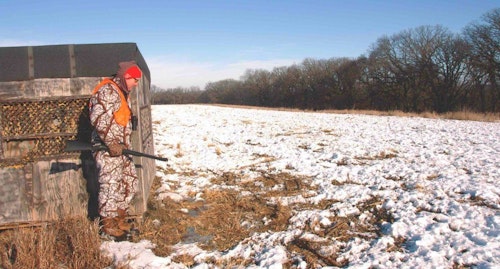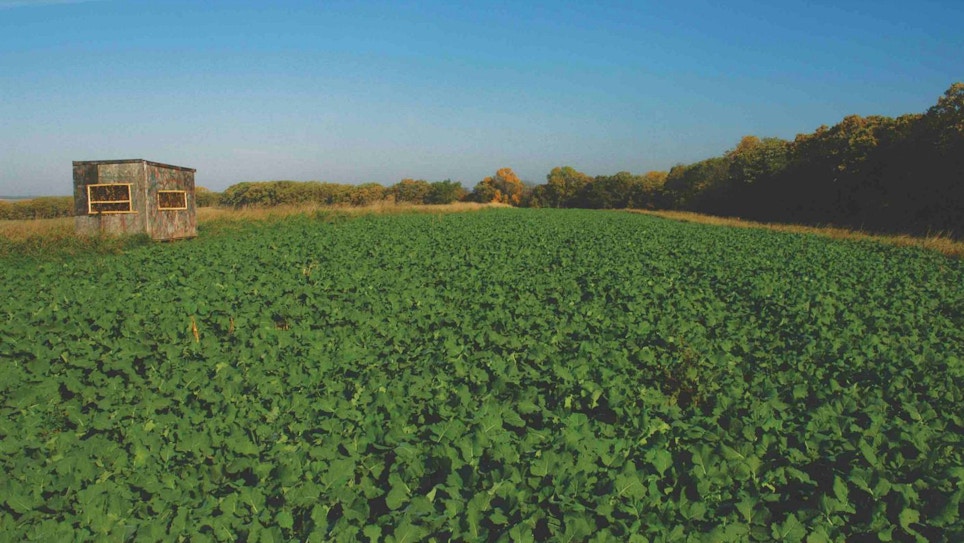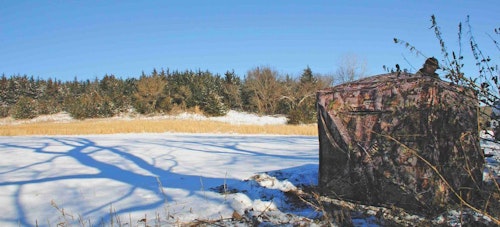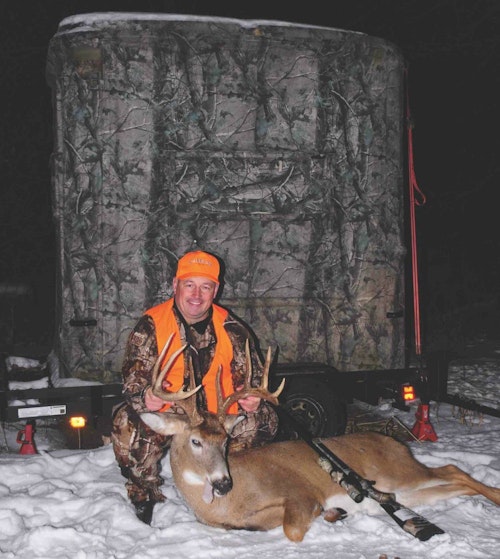An hour before the end of legal shooting light, I received this text message from my client: Come pick me up, I got a buck down. I LOVE it when a plan comes together!
The client, an avowed trophy hunter, was situated in a ground blind overlooking one of our most productive food plots. It consisted of 1.5 acres of soybeans and a little over a half-acre of brassicas. The combo is a deadly food plot, drawing deer from the early archery season through Iowa’s season end on January 10. This was the fourth time we had hunted this hidey-hole plot. A bowhunter had taken a 157-inch buck in early November, and two of our firearms hunters had scored on 150-inch bucks during each of the firearms seasons, the first 2 weeks of December.
We knew from trail camera photos that we still had several bucks in the 140-inch category, and a boomer 160-inch buck, along with 20 to 30 does, fawns, and smaller bucks, utilizing the plot on a regular basis.
On the way to the blind from camp, I told my client about the 160-class buck, advising him not to rush it, as he still had several days to hunt. He was in the process of telling me that he thought he had shot the 160-class buck, when I saw the antlers sticking up out of the unharvested soybeans 70 yards from his blind. I couldn’t believe what I was seeing. The buck he had shot was a humongous typical 10-point that gross scored 191 2⁄8 inches and netted 184 5⁄8 inches. Four times hunting a food plot and four trophy bucks killed, including one of the largest bucks we’ve taken in 20 years. That’s the fantastic part of food plots.

In contrast, several years earlier on one of our largest food plots (3.3 acres), where we normally take several great trophy bucks each year, we had less success. I had planted the food plot to Roundup Ready corn in the spring as part of the rotation program, with the intention of disking up half of it the first part of August to replant it with brassicas. I wasn’t sure whether I was more angry or devastated when I drove within sight of the plot and saw a dozen damnable black cows lazing in the annihilated cornfield. It was obvious they had been in there for some time because they had pretty much leveled the whole field.
When notified, the neighbor was quick to get the cattle off the lease and back behind his shoddy fence, and laughingly told me he’d bring a truckload of corn and dump it in the plot for the deer. Yeah right, and make me guilty of baiting deer? This was the second time his cattle had destroyed a food plot, and he wasn’t so jocular at the end of the civil action, when he wrote me a check to cover the damages and cost of replanting. We haven’t had a problem since that day.
Not one to give up easily, and with plenty of time for the brassicas to grow, I spent the next few days disking and replanting the food plot with high expectations for the quick-growing brassicas. When I headed back home to Colorado, the Iowa plot looked like a newly planted garden. Unfortunately, it looked almost the same when I returned for deer season in early October due to exceptionally dry, rainless weather. It’s the only year I remember that we didn’t kill a single deer out of that plot. That’s the foolhardy part of food plots.
If you approach utilizing food plots in a halfhearted manner, you may end up in a love/hate relationship. The following should help you to avoid the foolhardy and inspire you to attain the fantastic with regard to food plot relationships.
Food Plots Types
Some food plots are touted to increase the overall deer health, welfare, body size and antler development on your hunting grounds. I am not convinced that this type of food plot is possible with any degree of proven success, unless the deer are behind a high fence, under strictly controlled conditions, and you are willing to spend extra dollars on feed and mineral supplements.
Next, are food plots designed to coax deer within gun or bow rage. Sometimes called “kill plots,” these fields are definitely proven to work for any whitetail hunter that has access to a large chunk of whitetail habitat, and an undying desire to take a mature bucks.

If you don’t have the time, equipment and a green thumb to plant kill plots, and your hunting area has some grain crops such as corn, soybeans, winter wheat or oats, your best bet might simply be to offer to pay a landowner or farmer the going rate per bushel to create your food plot by not picking a portion of an existing field. We do this on all of our Iowa leases, in combination with our self-planted food plots to increase the effectiveness of our properties drawing and holding deer from surrounding properties. The result is more deer and more bucks to hunt throughout the season.
However, if this is the route you take, don’t just hand the landowner/farmer some cash and tell him to leave a half-acre of standing corn someplace in his large field. When farmers are in the harvesting mode and working several hundred acres or more, a 1-acre food plot or smaller is probably not going to be one of their priorities. If given the choice as to where to leave a food plot, they will more than likely do so where it is most convenient and easy for them — if they don’t forget altogether! Don’t’ take that gamble. Instead, take the time to scout your hunting area and choose a location that will be most advantageous to you, whether you are bowhunting, gun hunting or both.
When we pay a farmer to not pick a portion of a soybean or cornfield that we’ll utilize as a late-season food plot, we make our plot boundaries perfectly clear. Shortly before harvest time, we drive down a lane around the crop field with truck or four-wheeler and use wooden lathes with fluorescent orange flagging to clearly mark the exact location of our desired food plot. We do this even on leases we’ve had for 20 years because we never know what new farmhand might be driving the combine, and is unfamiliar or unaware of our plans.

Hunting Food Plots Effectively
Always keep the prevailing winds in mind when choosing a food plot location and a specific site for your stand or blind. An often overlooked aspect of stand or blind location, especially where food plots are concerned, is ease of access getting to your blind or stand without alerting deer. An even more important aspect to choosing your blind location, in conjunction with your food plot, is being able to exit and leave your blind or stand undetected. Spooking deer out of the plot will allow them to pinpoint the exact location of your blind or stand. Doing so is a sure way to drastically reduce the effectiveness of your food plot and make the deer nocturnal, especially wary, mature bucks. They don’t get big by being stupid!
Unobtrusive access is the main reason we drive our client’s right to the stand or blind in a vehicle and are adamant about them staying in the stand or blind until we come in to pick them up, especially if they have shot a deer. This aids in lessening the effects of lingering scent and human encroachment noises. Moreover, it keeps the attention of nearby deer on the familiar and innocuous sounds of a vehicle arriving and leaving, rather than on the hunter. Following these guidelines made the taking of the four bucks on four hunts in the opening scenarios possible.

When and What to Plant
If you are looking for deadly, DIY food plots, stick to early fall planting of seed blends that consist of sugar beets, rape, turnips, carrots, radishes, winter peas and winter wheat. There have been no new wildlife seed species discovered over the last 50 years or so, just different mixtures and marketing ploys to convince you to buy a certain product. Over the years, I have tried most of the individual species and many of the wildlife seed mixtures or blends. I have settled on two blends that have proven the most consistent in all weather conditions, growth results, attractiveness to deer, and palatability during and throughout deer season. The two blends I depend on are Frigid Forage’s (www.frigidforage.com) Big ‘N Beasty Brassicas and Autumn Quick Plot.
Putting in a deer-killing food plot is not rocket science and doesn’t require a whole shed full of expensive equipment. My clients and I have killed mature bucks over small hidey-hole food plots that I prepared and planted with nothing more than a small rototiller, hand seeder and rake. However, with the size food plots we utilize on our leases today, we commonly use an ATV to pull a disk, or one equipped with an electric seeder and a section of chain-link fencing for a drag.
Keep It Simple, Stupid
There is an infinite amount of information available on food plot development. I caution you to follow the KISS (keep it simple, stupid) principle. Start by talking to the landowner, farmer or seed dealer to get their input on soil pH conditions and proper fertilization. Concentrate your efforts on a late-summer/early fall planted food plot. In my opinion, the most important factor in the success or failure of your fall food plots — based on my 25 years of some phenomenally successful food plots, coupled with some equally monumental disastrous food plots — is patience and timing.
Weather can and will make or break your food plot ventures, and getting a good start on seed germination is a critical factor for a successful food plot. Get your food plot ground prepared and looking like a garden, but wait for a weather pattern that includes rain before actually planting and fertilizing. It’s tough to do sometimes when your time is limited, but believe me, without enough moisture shortly after planting, your food plot won’t make it.
That’s exactly what happened to me last fall, along with many other experienced food plot aficionados. In Iowa, abnormal weather patterns wreaked havoc. We prepared, planted and fertilized the plots the first of August, received a light rain shortly thereafter to germinate the seed, and then 20 days of hot, dry weather burned up the tender, susceptible plants. Fortunately, a complete replant followed by 4 to 6 inches of rain and regular showers after, produced exceptional follow-up food plots.
Following the age-old philosophy, the harder you work, the luckier you’ll get, when it comes to food plots can turn your food plot ventures from foolhardy to fantastic. You’ll soon be addicted to their use, forever!








